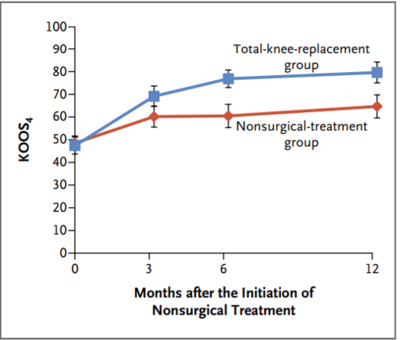Knee Osteoarthritis: Difference between revisions
No edit summary |
No edit summary |
||
| Line 1: | Line 1: | ||
{{partial}} | {{partial}} | ||
==Epidemiology== | |||
The lifetime risk of total knee replacement in New Zealand has grown rapidly from 2000 to 2015. The risk for females increased from 9.4% in 2000 to 16.8% in 2015, a relative increase of 78%. Males increased from 8.1% in 2000 to 16.0% in 2015, a relative increase of 97%.<ref>{{#pmid:30703779}}</ref> | |||
==Treatment== | ==Treatment== | ||
===Non-Pharmacological=== | ===Non-Pharmacological=== | ||
Revision as of 10:04, 23 June 2021
Epidemiology
The lifetime risk of total knee replacement in New Zealand has grown rapidly from 2000 to 2015. The risk for females increased from 9.4% in 2000 to 16.8% in 2015, a relative increase of 78%. Males increased from 8.1% in 2000 to 16.0% in 2015, a relative increase of 97%.[1]
Treatment
Non-Pharmacological
Exercise Therapy
Reduces pain and improves function partially through anti-inflammatory effects in particular IL-6 even without weight loss Maximal benefit at 2 months, thereafter slowly diminishes, being no better than usual care at 9 to 18 months – possibly due to poor adherence. Better effects in those who are younger, with milder OA and who weren’t awaiting knee replacement. Doesn’t harm the cartilage [2]
Physical therapy is more effect than a single glucocorticoid injection at one year[3]
Weight Loss
Adipokines directly involved in inflammatory component of OA and cartilage damage Best results with combined diet plus exercise E.g. IDEA trial exercise plus weight loss 50% decrease in pain scores, and 38% of patients reported no or little pain at the end of the trial Dose response curve, best results with at least 10% weight loss In the elderly should combine weight loss with strengthening exercises There appears to be a benefit from bariatric surgery, too. [4]
Manual Therapy
Mobilisation with movement improves pain, range of motion, and functional[5]
Insoles
Probably not effective
Medial knee OA – negative meta-analysis of 12 studies in 2013 for lateral wedge insoles when compared to a neutral insole. Publication bias was detected.[6] [LOE 1a-]
Lateral knee OA – one small study showing benefit with medial wedge insoles
Pharmacological
Topical Therapies
Capsaicin
- Desensitisation of nociceptive fibres
- Causative role of substance P depletion has come into question
- Local burning, improves with continued application
- Funded if NSAIDs contraindicated
Topical NSAIDs
- Cochrane 60% achieved at least 50% improvement (better than placebo)
- Comparable to oral formulations
Supplements
A systematic review concluded that the following supplements had the most evidence: L-carnitine, Pycnogenol, curcumin, Boswellia serrata extract, Curcuma longa extract, passion fruit peel extract, and collagen hydrolysate. [8]
Surgery
Total Knee Joint Replacement
- Resection of diseased surface, resurfacing with metal and polyethylene components
- No sham studies
- Reduced pain and improved quality of life (compared to non surgical treatment – exercise, diet, insoles, medication)
- 20% experience chronic pain after surgery, causes not fully understood (but strong psychological risk factors)
- Risks – DVT and stiffness requiring brisement force most common
On the topic of chronic pain post surgery, probably the best study is a non placebo controlled study by Skou et al who found a significant proportion still experienced chronic pain after surgery. [9]
Possible factors contributing to persistent pain following surgery are summarised by Wylde et al. M
| Factor | Examples |
|---|---|
| Biological | Sensitizing impact of long-term pain from osteoarthritis Complex Regional Pain Syndrome Pain originating from the hip Patellofemoral pain Allergy-related problem Inflammatory response |
| Surgical | Infection Localized nerve injury Prosthetic loosening Malalignment Malrotation Incorrect sizing Instability Stiffness |
Arthroscopic Debridement
In one of the only placebo controlled trials in all of orthopaedic surgery, this procedure was proven to be no better than sham surgery and should no longer be performed. [10]
Unicompartmental arthroplasty
- quicker recovery and improved ROM
- Younger patients with low activity demands
Osteotomy
- High tibial osteotomy (for varus knee)
- Distal femoral Osteotomy (for valgus knee)
- Younger patients with high activity demands and�poor alignment.
Again there are no sham studies [11]
Injection Treatments
Steroid Injections
No better than placebo with an increased risk of accelerated cartilage loss [12]
PRP
Dextrose Prolotherapy
A systematic review found high risk of bias and that prolotherapy was no different from platelet-rich plasma on the pain subscale at the 6-month time point, and was inferior to platelet-rich plasma at 6 months.[13]
References
- ↑ Henzell et al.. Lifetime risk of primary total knee replacement surgery in New Zealand from 2000 to 2015. The New Zealand medical journal 2019. 132:48-56. PMID: 30703779.
- ↑ Goh, S.-L., Persson, M. S., Stocks, J., Hou, Y., Lin, J., Hall, M. C., … Zhang, W. (2019). Efficacy and potential determinants of exercise therapy in knee and hip osteoarthritis: a systematic review and meta-analysis. Annals of Physical and Rehabilitation Medicine.
- ↑ Deyle et al.. Physical Therapy versus Glucocorticoid Injection for Osteoarthritis of the Knee. The New England journal of medicine 2020. 382:1420-1429. PMID: 32268027. DOI.
- ↑ Messier, S. P., Beavers, D. P., Mihalko, S. L., Miller, G. D., Lyles, M. F., Hunter, D. J., … DeVita, P. (2019). The effects of intensive dietary weight loss and exercise on gait in overweight and obese adults with knee osteoarthritis the intensive diet and exercise for arthritis (idea) trial. Journal of Biomechanics, 109477.
- ↑ Gidey Gomera Weleslassie, Melaku Hailu Temesgen, Abayneh Alamer, Gebrerufael Solomon Tsegay, Teklehaimanot Tekle Hailemariam, Haimanot Melese, "Effectiveness of Mobilization with Movement on the Management of Knee Osteoarthritis: A Systematic Review of Randomized Controlled Trials", Pain Research and Management, vol. 2021, Article ID 8815682, 12 pages, 2021. DOI
- ↑ Parkes MJ, Nasimah M, Lunt M, et al. Lateral wedge insoles as conservative treatment for pain in patients with medial knee osteoarthritis. A meta-analysis. JAMA 2013;310(7):722-730.
- ↑ Derry S, Conaghan P, Da Silva JAP, Wiffen PJ, Moore RA. Topical NSAIDs for chronic musculoskeletal pain in adults. Cochrane Database of Systematic Reviews 2016, Issue 4. Art. No.: CD007400. DOI: 10.1002/14651858.CD007400.pub3.
- ↑ Liu et al.. Dietary supplements for treating osteoarthritis: a systematic review and meta-analysis. British journal of sports medicine 2018. 52:167-175. PMID: 29018060. DOI.
- ↑ Skou, S. T., Roos, E. M., Laursen, M. B., Rathleff, M. S., Arendt-Nielsen, L., Simonsen, O., & Rasmussen, S. (2015). A Randomized, Controlled Trial of Total Knee Replacement. New England Journal of Medicine, 373(17), 1597–1606.
- ↑ Moseley, J. B., O’Malley, K., Petersen, N. J., Menke, T. J., Brody, B. A., Kuykendall, D. H., … Wray, N. P. (2002). A Controlled Trial of Arthroscopic Surgery for Osteoarthritis of the Knee. New England Journal of Medicine, 347(2), 81–88. doi:10.1056/nejmoa013259
- ↑ Dettoni F, Bonasia DE, Castoldi F, Bruzzone M, Blonna D, Rossi R. High tibial osteotomy versus unicompartmental knee arthroplasty for medial compartment arthrosis of the knee: a review of the literature. Iowa Orthop J. 2010;30:131–140.
- ↑ McAlindon TE, LaValley MP, Harvey WF, et al. Effect of intra-articular triamcinolone vs saline on knee cartilage volume and pain in patients with knee osteoarthritis: a randomized clinical trial. JAMA 2017;317(19):1967-1975.
- ↑ Wee et al.. Dextrose prolotherapy in knee osteoarthritis: A systematic review and meta-analysis. Journal of clinical orthopaedics and trauma 2021. 19:108-117. PMID: 34046305. DOI. Full Text.
Literature Review
- Reviews from the last 7 years: review articles, free review articles, systematic reviews, meta-analyses, NCBI Bookshelf
- Articles from all years: PubMed search, Google Scholar search.
- TRIP Database: clinical publications about evidence-based medicine.
- Other Wikis: Radiopaedia, Wikipedia Search, Wikipedia I Feel Lucky, Orthobullets,



